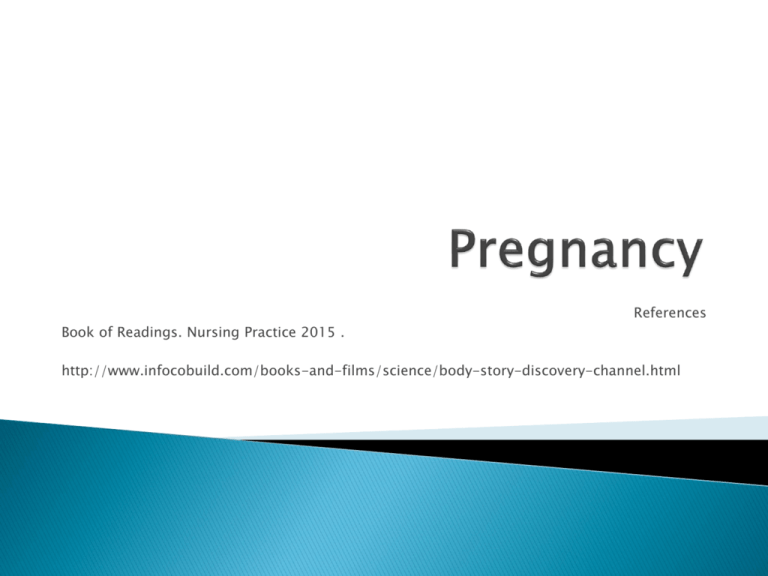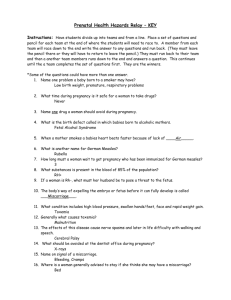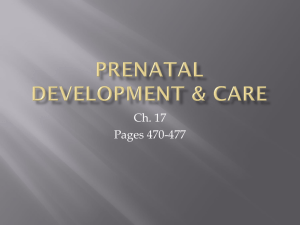Pregnancy
advertisement

References Book of Readings. Nursing Practice 2015 . http://www.infocobuild.com/books-and-films/science/body-story-discovery-channel.html Key words, concepts from which to describe the basic process of conception: -the menstrual cycle, ovulation, -mitosis, meiosis, gamete, ovum, spermatozoa, -zygote, morula, blastocyst Refer to www.google.com images Prenatal growth -germinal stage (fertilisation to 2 weeks) organism divides….rapid cell division, increasing complexity, …..implants in the uterus….forms the placenta and amniotic fluid. -embyonic stage (2 to 12 weeks) major body systems and organs develop. critical stage of development. -fetal stage (12 weeks to birth) increasing development and growth. The mother’s experience Signs and symptoms of pregnancy presumptive signs and symptoms -may have causes other than pregnancy -amenorrhoea -nausea and vomiting -urinary frequency -breast tenderness -quickening Probable signs of pregnancy -may have causes other that pregnancy -changes in pelvic organs -enlargement of the abdomen -Braxton Hicks contractions -pigmentation of the skin (linea nigra / areola) -pregnancy test (hydatiform mole) Positive signs of pregnancy -signs observed by the examiner -can only be caused by pregnancy -fetal heart beat heard (piniards or a sonocaid) http://www.google.co.nz/imgres?imgurl=http:// -fetal movements palpable by an examiner http://blog.soliant.com/wp-content/uploads/ultrasound-technician.jpg -visualisation of the fetus (ultrasound) Human gestation = 266 days (9 months) Naegle’s rule -to find out the -(EDD) estimated date of delivery -(EDB) estimated date of birth Take the first day of the woman’s last normal menstrual period, add on 7 days and take off 3 months (or add on 9 months). eg. LNMP 18 July 2003 18 +7 days=25 July + 9 months =April EDD or EDB= 25th April 2004 Hormones of pregnancy Human Chorionic Gonadotropin (hCG) or (HCG) -secreted early in pregnancy, stimulates progesterone & oestrogen production by the corpus luteum to maintain the the pregnancy until the placenta is developed to assume that function. -the presence of HCG (hCG) in the urine is the basis for most commonly used pregnancy tests. Estrogen (oestrogen) - growth hormone produced by the ovaries, corpus luteum and the placenta -stimulates uterine development (growth of the decidua and myometrium) to provide a suitable environment for the fetus. -stimulates development of the ductal system of the breast tissue in preparation for lactation (breastfeeding) -contributes to water retention -excreted in urine (oestriol) (when collected give an indication of the health of the pregnancy). http://www.greenthinkers.org/blog/uploaded_images/trucker_bottle_poster1.standard-744039.jpg Progesterone -secretory hormone secreted by the corpus luteum and the placenta. -maintains the pregnancy, maintains the endometrium and stops spontaneous uterine contractility. -relaxes smooth muscle fibres. (ureters, veins, arteries, uterus, intestine…) …discomforts of pregnancy Maternal nutrition “A woman’s nutritional status before and during pregnancy can significantly influence her health and the health and that of her fetus.” Ladewig, P., London, M., Olds, S. (1998) Maternal-Newborn nursing care . Fourth edition. Addison Wesley. Maternal nutrition -important to eat a variety of foods -quality better than quantity -iron, folic acid, calcium -water intake (review nutrition according to tutorial guidelines) Weight gain during pregnancy. Mother -uterus 1.0 kg -breasts 0.5 kg -blood volume 3.0 kg -fat and protein stores 3.0 kg Fetus -average weight at birth 3.5 kg -amniotic fluid (1L+) 1.0 kg -placenta (average wgt) 0.5 kg Overall minimal weight gain = 12.5 kg Minimum recommended weight gain = 12.5 kg Referring to the previous chart most of the weight gained results from new tissue and fluid volume for the mother and fetus. Weight gain during pregnancy needs to be assessed in relation to: -the woman’ pre-pregnant weight -ideal weight for height and bone structure MOH (2006) Food and Nutrition Guidelines for Healthy Pregnant and Breastfeeding Women. Low BMI Normal BMI High BMI Obese BMI 12.5-18.0 kg 11.5-16.0 kg 7.0-11.0 kg 6.0 kg The Placenta The placenta -functions: -respiration: O2 and CO2 -nutrition: water / glucose / electrolytes -excretion: CO2 / wastes, urea -secretion of hormones -develops progressively throughout the pregnancy - by 37-42 weeks : ovular-circular 1/5 of the baby’s weight diameter 18-2- cms. the maternal and fetal circulations do not mix *simple diffusion (high conc. To lower) * facilitated diffusion (osmosis / active transfer) The membranes The membranes (amnion and chorion) -amnion: thin protective membrane that entirely surrounds the embryo. -chorion: outside the amnion and surrounds the fetus. http://t3.gstatic.com/images?q=tbn:ANd9GcSKJPksNZIQjhkQGQ2NEfVDBLuiKsnkEhh38FhGVKrO6wBM _No&t=1&usg=__zY_B78IkBvx8EVKNqIFH2nIiiZg= Born in a caul Amniotic fluid -the fluid surrounding the embryo inside the amnion. -clear straw coloured -approximately 1500 mls. -protects the fetus from trauma and temperature changes -allows room for growth and movement A pregnant women should contact her LMC at the routine times or as negotiated and with any of the following: -vaginal bleeding -premature labour -rupture of the membranes -decreased fetal movements -severe headaches, visual blurring or “ spotting of vision”, swelling Fetal movement chart / Kick Chart non-invasive assessment of fetal well being carried out by the mother. Mother notes on the chart the time when she has felt 10 kicks each day (she starts counting at the same time each day eg 0700 hours). -a pattern will emerge over a few days. If the pattern changes to very few or no kicks late in the day contact her LMC Miscarriage Miscarriage -a miscarriage is a pregnancy that ends spontaneously before 20 weeks gestation. (about 1 in 4 pregnancies ends in a miscarriage and 99% before 13 weeks). It occurs basically because something went wrong during or soon after conception Reasons for a miscarriage include: -chromosomal abnormality, poor implantation of the blastocyst, hormonal changes, changes in the uterus or cervix…. Typically a woman will notice some bleeding, some pain, other signs of pregnancy such as breast tenderness may disappear. During the miscarriage the cervix opens, and the conceptus comes away from the uterine wall and passes out through the cervix. A woman needs to be observed for the amount of blood lost, supported through any pain, and emotional support is necessary following the experience. It is important to ensure that the uterus is emptied fully to avoid further bleeding and infection. This may occur naturally or a dilatation and curratage (D&C) may be performed. Often an ultrasound is completed. Abortion -abortion is the common medical term for all pregnancies that end before 20 weeks. (compare to miscarriage) take care when using these terms. An abortion (termination of pregnancy) is purposeful evacuation of the uterus, most commonly and safest carried out before 12 weeks gestation. New Zealand laws include (2 consultants, potential harm for mother or baby, women under 16 can sign consent forms…..) -ethical and moral issues for nurses, patients the community -follow up care is important. It is important that pregnant women receive ongoing antenatal care Terminology/ definitions -full term infant: -premature infant: born between 37-42 weeks born before 37 weeks -postmature infant: born after 42 weeks. IUGR intrauterine growth retardation -gravida: any pregnancy, regardless of duration -prima gravida: a woman pregnant for the 1st time -para: a pregnancy proceeding to after 20 weeks gestation. (prima para) a woman who is having her 2nd or any subsequent pregnancy time passed since the first day of the last normal menstrual period,(LNMP) measured in weeks -multigravida: -gestation:




